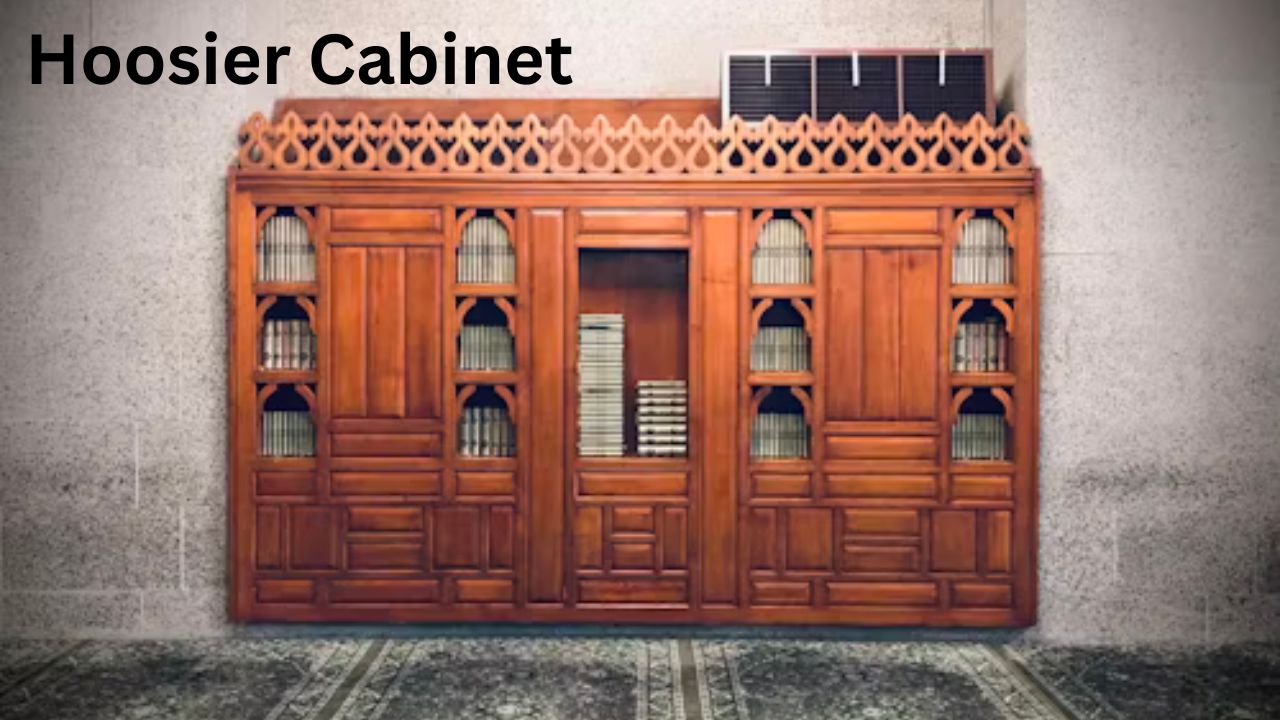Imagine walking into your grandma’s old kitchen — the smell of cookies baking, the gentle hum of a fan, and right there against the wall stands a beautiful piece of furniture with flour in a bin, spice jars neatly arranged, and drawers full of memories. That, my friend, is a hoosier cabinet — a timeless piece that brings warmth, nostalgia, and a sense of simpler living back to modern homes.
What is a Hoosier Cabinet?
Let’s start with the basics: what is a hoosier cabinet?
A hoosier cabinet is a special kind of freestanding kitchen cabinet that became popular in the early 1900s, long before built-in kitchen cabinets were common. Think of it as a mini kitchen station — a mix between a cupboard, pantry, and workstation all rolled into one.
Typically, a hoosier cabinet comes with three main parts:
- An upper section with shelves and small compartments.
- A middle workspace, often with a pull-out counter made of wood or enamel.
- A lower section with drawers and cupboards for storage.
Some models even include clever features like a built-in flour sifter, spice racks, and a pull-out breadboard. These designs made cooking and baking easier for homemakers of the early 20th century.
When you see a hoosier cabinet with flour sifter, you’re looking at the heart of early kitchen innovation — where convenience met craftsmanship. That flour sifter wasn’t just a tool; it was a time-saver in a busy household.
A Short Stroll Through History
The first hoosier cabinets were produced around the late 1890s and became household essentials by the 1920s. The name “Hoosier” actually came from the Hoosier Manufacturing Company of New Castle, Indiana. They were among the first to make this furniture style famous — so much that “Hoosier” became a household name.
Back then, homes didn’t have built-in cabinetry or modern appliances. The hoosier kitchen cabinet offered an all-in-one solution. It had special compartments for sugar, flour, coffee, spices, and utensils. It turned cooking into a more organized, efficient process — something revolutionary at the time!
Soon after, other manufacturers joined in — like Sellers, McDougall, and Boone — each adding their own twists. You might have heard of the sellers hoosier cabinet, known for its craftsmanship and innovative design.
By the 1940s, kitchens started getting built-in cabinets, and the 1940 hoosier cabinet marked one of the last eras of this furniture’s golden age. Though production slowed, the charm never faded.
The Unique Features that Make It Special
Every hoosier cabinet tells a story — not just through its age, but through its details.
Here are a few features that make these cabinets stand out:
- Flour Sifter & Bin: The famous hoosier cabinet flour bin and hoosier cabinet with flour sifter combo made baking fast and efficient. Homemakers could measure and sift flour directly from the cabinet!
- Spice Racks & Glass Jars: Small labeled jars neatly organized on the shelves — the earliest version of “Pinterest-worthy” storage.
- Pull-Out Worktops: The slide-out counter offered more workspace, which was ideal for kneading dough or prepping meals.
- Hidden Compartments: Some antique hoosier cabinets have secret drawers or compartments that were used to store recipes or money — a little mystery in every kitchen.
These features made the vintage hoosier cabinet not only practical but deeply personal. Each one reflects the creativity and culture of its time.
Types and Styles of Hoosier Cabinets
While all hoosier cabinets share the same purpose, they come in a variety of designs.
Some of the most notable include:
- Antique hoosier cabinet – Usually made between 1910–1930, crafted from oak or maple, featuring hand-carved details and classic flour sifters.
- Vintage hoosier cabinet – Slightly newer models from the 1940s or 1950s, often with enamel countertops and simpler styling.
- 1920’s antique hoosier cabinet – Highly collectible today, these showcase the golden age of craftsmanship with signature hardware and flour bins.
- Hoosier minneapolis cabinet – A regional variation often admired for its robust design and extra storage.
- Sellers hoosier cabinet – Known for patented innovations and quality finishes.
Each type has its own charm, making it easy to find one that matches your personal taste — whether you love rustic farmhouse style or vintage elegance.
Why Hoosier Cabinets Are Making a Comeback
In today’s fast-paced world, where everything is sleek, modern, and minimal, there’s something heartwarming about bringing home a piece of history. The hoosier kitchen cabinet offers that cozy, nostalgic feeling that instantly transforms a space.
Homeowners and interior designers love adding a vintage hoosier cabinet or antique hoosier cabinet to their kitchens because it adds warmth, character, and a story. It’s not just furniture; it’s a conversation piece — a link between generations.
Moreover, the functionality still holds up! With a little restoration, these cabinets can serve as:
- Coffee or tea stations
- Baking centers
- Storage for modern kitchen gadgets
- Decorative pieces in dining rooms or pantries
When styled right, a hoosier cabinet fits beautifully into both vintage-inspired and modern farmhouse interiors.
Buying and Collecting Hoosier Cabinets
If you’re on the hunt for a hoosier cabinet for sale or hoosier cabinets for sale, you’ll notice they vary in condition and price. Original antique hoosier cabinet for sale listings can range anywhere from a few hundred to several thousand dollars, depending on age, craftsmanship, and completeness.
Here’s what to look for:
- Authenticity: Check for maker’s marks or labels like “Hoosier Mfg. Co.” or “Sellers.”
- Condition: Make sure the drawers slide easily, the flour sifter works, and the enamel top is intact.
- Hardware: Genuine hoosier cabinet hardware and hoosier cabinet hardware parts often determine a piece’s true value.
- Completeness: A fully equipped hoosier cabinet with flour bin and original accessories is always more valuable than a partial one.
- Age: A 1920’s antique hoosier cabinet or an old hoosier cabinet for sale can fetch a higher price, especially if it’s in good shape.
Collectors often restore old units, sourcing hoosier cabinet parts or hoosier cabinet hardware parts online or through antique shops. There’s a whole community of enthusiasts who help identify, restore, and trade these treasures — making it an exciting hobby for vintage lovers.
How to Identify a Genuine Hoosier Cabinet
You might wonder how experts tell if a piece is authentic. Here are some clues that can help with hoosier cabinet identification:
- Look for metal flour sifters or flour bins inside the upper cabinet.
- Examine the hardware — original knobs and hinges often have unique designs.
- Check for manufacturer’s stamps or paper labels (often found inside drawers or on the back panel).
- Note the wood type — oak, maple, or enamel-topped surfaces were standard materials.
- Compare the design with catalogs or online guides to match your find to a specific year or maker.
Proper hoosier cabinet identification helps you know the cabinet’s history and value — whether you’re restoring it, displaying it, or selling it.
Restoring the Beauty of an Old Hoosier Cabinet
Finding an old hoosier cabinet for sale is like finding a hidden gem. But before you bring it home, consider restoration.
Start by cleaning the wood with mild soap and water, repairing any broken shelves, and polishing the hardware. If the hoosier cabinet flour bin or sifter is missing, you can often find replacements as hoosier cabinet parts online.
Restoring a vintage hoosier cabinet for sale can be incredibly rewarding. You not only revive a historic piece but also add a charming, functional element to your kitchen.
Why People Still Love Them
At its heart, the hoosier cabinet represents more than just furniture. It stands for family, tradition, and the joy of home cooking. It reminds us of the days when everything was made by hand — from the bread in the oven to the furniture in the kitchen.
Owning a hoosier kitchen cabinet for sale or restoring an antique hoosier cabinet gives people a way to hold onto that sense of connection. It’s a small reminder that even in a digital world, the beauty of craftsmanship never fades.
So, whether you’re a collector, a designer, or just someone who loves the charm of old-world furniture, the hoosier cabinet will always have a special place in your home — and your heart.


